Rubisco and Rubisco Activase Play an Important Role in the Biochemical Limitations of Photosynthesis in Rice, Wheat, and Maize under High Temperature and Water Deficit
- PMID: 28450871
- PMCID: PMC5390490
- DOI: 10.3389/fpls.2017.00490
Rubisco and Rubisco Activase Play an Important Role in the Biochemical Limitations of Photosynthesis in Rice, Wheat, and Maize under High Temperature and Water Deficit
Abstract
To understand the effect of heat and drought on three major cereal crops, the physiological and biochemical (i.e., metabolic) factors affecting photosynthesis were examined in rice, wheat, and maize plants grown under long-term water deficit (WD), high temperature (HT) and the combination of both stresses (HT-WD). Diffusional limitations to photosynthesis prevailed under WD for the C3 species, rice and wheat. Conversely, biochemical limitations prevailed under WD for the C4 species, maize, under HT for all three species, and under HT-WD in rice and maize. These biochemical limitations to photosynthesis were associated with Rubisco activity that was highly impaired at HT and under HT-WD in the three species. Decreases in Rubisco activation were unrelated to the amount of Rubisco and Rubisco activase (Rca), but were probably caused by inhibition of Rca activity, as suggested by the mutual decrease and positive correlation between Rubisco activation state and the rate of electron transport. Decreased Rubisco activation at HT was associated with biochemical limitation of net CO2 assimilation rate (AN). Overall, the results highlight the importance of Rubisco as a target for improving the photosynthetic performance of these C3 (wheat and rice) and C4 (maize) cereal crops under increasingly variable and warmer climates.
Keywords: Rubisco; Rubisco activase; crops; photosynthesis; temperature; water deficit.
Figures
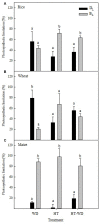
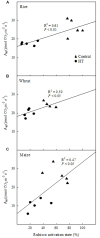
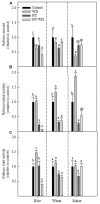
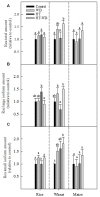
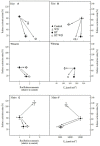
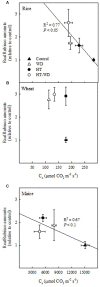
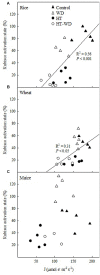
Similar articles
-
Acclimation of Biochemical and Diffusive Components of Photosynthesis in Rice, Wheat, and Maize to Heat and Water Deficit: Implications for Modeling Photosynthesis.Front Plant Sci. 2016 Nov 22;7:1719. doi: 10.3389/fpls.2016.01719. eCollection 2016. Front Plant Sci. 2016. PMID: 27920782 Free PMC article.
-
Two Rubisco activase isoforms may play different roles in photosynthetic heat acclimation in the rice plant.Physiol Plant. 2010 May;139(1):55-67. doi: 10.1111/j.1399-3054.2009.01344.x. Epub 2010 Jan 3. Physiol Plant. 2010. PMID: 20059735
-
Drought stress and carbon assimilation in a warming climate: Reversible and irreversible impacts.J Plant Physiol. 2016 Sep 20;203:84-94. doi: 10.1016/j.jplph.2016.04.002. Epub 2016 Apr 7. J Plant Physiol. 2016. PMID: 27083537 Review.
-
Effects of OsRCA Overexpression on Rubisco Activation State and Photosynthesis in Maize.Plants (Basel). 2023 Apr 11;12(8):1614. doi: 10.3390/plants12081614. Plants (Basel). 2023. PMID: 37111838 Free PMC article.
-
The temperature response of C(3) and C(4) photosynthesis.Plant Cell Environ. 2007 Sep;30(9):1086-106. doi: 10.1111/j.1365-3040.2007.01682.x. Plant Cell Environ. 2007. PMID: 17661749 Review.
Cited by
-
Photosynthesis in non-foliar tissues: implications for yield.Plant J. 2020 Feb;101(4):1001-1015. doi: 10.1111/tpj.14633. Epub 2020 Jan 29. Plant J. 2020. PMID: 31802560 Free PMC article. Review.
-
Identification of drought responsive proteins and related proteomic QTLs in barley.J Exp Bot. 2019 May 9;70(10):2823-2837. doi: 10.1093/jxb/erz075. J Exp Bot. 2019. PMID: 30816960 Free PMC article.
-
Expression of a Small Ubiquitin-Like Modifier Protease Increases Drought Tolerance in Wheat (Triticum aestivum L.).Front Plant Sci. 2019 Mar 8;10:266. doi: 10.3389/fpls.2019.00266. eCollection 2019. Front Plant Sci. 2019. PMID: 30906307 Free PMC article.
-
Sensitivity and Responses of Chloroplasts to Heat Stress in Plants.Front Plant Sci. 2020 Apr 2;11:375. doi: 10.3389/fpls.2020.00375. eCollection 2020. Front Plant Sci. 2020. PMID: 32300353 Free PMC article. Review.
-
Progress in Research on the Mechanisms Underlying Chloroplast-Involved Heat Tolerance in Plants.Genes (Basel). 2021 Aug 28;12(9):1343. doi: 10.3390/genes12091343. Genes (Basel). 2021. PMID: 34573325 Free PMC article. Review.
References
-
- Aranjuelo I., Perez P., Hernandez L., Irigoyen J. J., Zita G., Martinez-Carrasco R., et al. (2005). The response of nodulated alfalfa to water supply, temperature and elevated CO2: photosynthetic downregulation. Physiol. Plant. 123 348–358. 10.1111/j.1399-3054.2005.00459.x - DOI
-
- Bernacchi C. J., Portis A. R., Nakano H., von Caemmerer S., Long S. P. (2002). Temperature response of mesophyll conductance. Implications for the determination of Rubisco enzyme kinetics and for limitations to photosynthesis in vivo. Plant Physiol. 130 1992–1998. 10.1104/pp.008250.water - DOI - PMC - PubMed
LinkOut - more resources
Full Text Sources
Other Literature Sources
Miscellaneous

